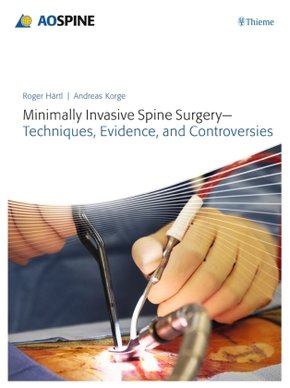Minimally Invasive Spine Surgery - Techniques, Evidence, and Controversies
| Verlag | Thieme |
| Auflage | 2012 |
| Seiten | 490 |
| Format | 21,7 x 28,2 x 3,1 cm |
| Hardback (Thread Stitching) | |
| Gewicht | 1914 g |
| Artikeltyp | Englisches Buch |
| ISBN-10 | 3131723815 |
| EAN | 9783131723819 |
| Bestell-Nr | 13172381A |
Minimally invasive spine surgery, in some form or other, has historical roots dating back more than 100 years, and recent advances in technology now make it increasingly effective in treating suitable spine patients. While minimally invasive approaches have shown to reduce muscle damage, blood loss, and post-operative pain, to perform this t ype of surgery correctly, even highly skilled modern-day surgeons must prepare themselves for a demanding learning curve.
For this reason, AOSpine proudly presents Minimally Invasive Spine Surgery: Techniques, Evidence, and Controversies, the most comprehensive book of its kind, which includes more than 500 pages of surgical techniques, illustrations, case images, tips and tricks, and research, providing an invaluable tool for spine surgeons around the world.
Each technique is fully examined:
- The pros and cons of each is objectively reviewed
- Its spectrum of indications and contraindications is summarized
- Histor ical and modern day controversies relating to each technique are discussed
- Uniquely, chapters in the text are further supported by an evidence-based section summarizing research studies, analysis, and conclusions into each technique, from peer-reviewed journals
The text covers more than just a range of interesting medical techniques. By including brief historical introductions on each technique and the surgeons that explored and founded its methods, their early (sometimes self-made) instrumentation, right through to todays current best-practice, this book provides an interesting, informative, and topical instruction on minimally invasive surgery and its increasingly encouraging results for spine-patient care.
Inhaltsverzeichnis:
1 Fundamentals
1.1 The definition of minimally invasive spine surgery and the rationale for its use
1.2 Minimally invasive spine surgery and AOSpine principles
1.3 The four pillars of minimally invasive spine surgery
1.4 Evidence-based medicine and minimally invasive spine surgery
1.5 Different spinal pathologies and patient selection
1.6 Computer-assisted navigation for minimally invasive spine surgery
1.7 Biologics in minimally invasive spine surgery
1.8 Anesthetic considerations and minimally invasive spine surgery
2 Cervical techniques
2.1 Introduction
2.2 Posterior foraminotomy
2.3 Anterior foraminotomy: microsurgical and endoscopic procedures
2.4 Posterior C1/2 transarticular screw fixation
2.5 Anterior C1/2 surgery
3 Thoracic techniques
3.1 Introduction
3.2 Extreme lateral mini-thoracotomy approach for thoracic spinal pathologies
3.3 Anterior thoracoscopic approaches, including fracture treatment
3.4 Posterior app roaches for minimally invasive thoracic decompression and stabilization
3.5 Posterior approaches for minimally invasive treatment of spinal fractures
3.6 Vertebroplasty and percutaneous cement reinforcement techniques
4 Lumbar/sacral techniques
4.1 Introduction
4.2 Posterior approaches
4.3 Anterior approaches
5 Critical overview and outlook
5.1 Minimally invasive spine surgery: a critical overview and outlook

